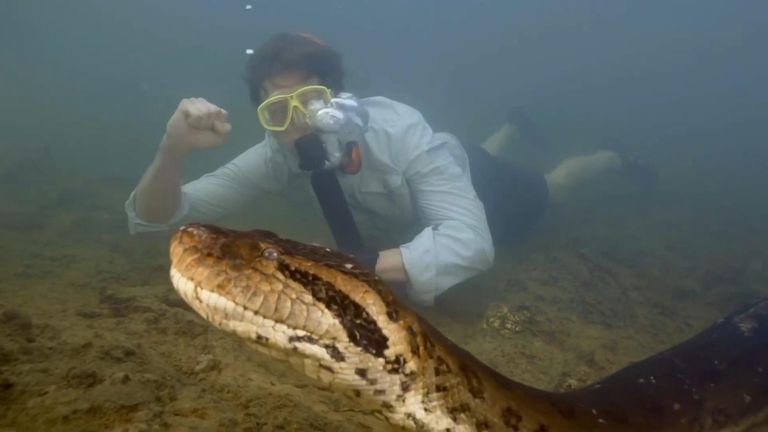Latin America
Related: About this forumNew giant anaconda species found in Ecuador Amazon during filming of Will Smith documentary
Last edited Sun Feb 25, 2024, 10:09 PM - Edit history (1)
Feb 24, 2024 |
By Emilee Coblentz
A giant anaconda species thought to be the largest in the world has been captured deep in the Amazon of Ecuador by a team of scientists from The University of Queensland.

A diver approaches a green anaconda under water.
The group of scientists, led by professor Bryan Fry, uncovered the nearly 10 million-year-old species with help from the indigenous Huaorani people while filming “Pole to Pole with Will Smith,” a National Geographic series streaming on Disney+ and hosted by the Oscar winner.
“The size of these magnificent creatures was incredible,” Fry said in a news release. “One female anaconda we encountered measured an astounding 6.3 meters (20.8 feet) long.”
The invitation by Huaorani Chief Penti Baihua to enter the Baihuaeri Huaorani Territory in the Ecuadorian Amazon was “one of only a handful granted since the tribe’s first contact in 1958,” Fry told USA TODAY on Thursday.
More:
https://cuencahighlife.com/new-giant-anaconda-species-found-in-ecuador-amazon-during-filming-of-will-smith-documentary/
~ ~ ~
New Species of Anaconda Discovered in Orinoco Basin
Feb 20, 2024 by Natali Anderson
An international team of herpetologists led by New Mexico Highlands University and University of Queensland scientists has described a cryptic new species of anaconda from the remote Amazon.

Eunectes akayima. Image credit: Rivas et al., doi: 10.3390/d16020127.
Anacondas (genus Eunectes) are a group of aquatic snakes endemic to the east of the Andes in South America.
These large-bodied snakes inhabit lowland rivers and wetlands; they have the typical adaptations for an aquatic lifestyle, such as nostrils and eyes located dorsally on the head, and displaying a dorsal coloration and pattern that blend well with the aquatic vegetation.
Before this study, four species were recognized in the genus, with Eunectes murinus representing a sister lineage to a group composed of Eunectes beniensis, Eunectes deschauenseei, and Eunectes notaeus.
The largest of these species, Eunectes murinus, or the green anaconda, occurs in most of the tropical regions of the continent, including the basins of the Amazon, Esequibo, and Orinoco rivers, and several smaller watersheds.
. . .
“The size of these magnificent creatures was incredible — one female anaconda we encountered measured an astounding 6.3 m (20.7 feet) long.”
“There are anecdotal reports from the Waorani people of other anacondas in the area measuring more than 7.5 m (24.6 feet) long and weighing around 500 kg.”
More:
https://www.sci.news/biology/eunectes-akayima-12702.html
Chi67
(1,103 posts)That is a really beautiful animal.
Bayard
(24,145 posts)I rather like snakes, but that one would give me pause.
KarenS
(4,632 posts)Yikes!
500kg is 1100 lbs.